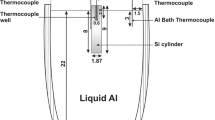Abstract
Experimental measurements are reported on melt velocities and on the rate at which immersed carbon rods dissolve in a 4-ton induction furnace, holding a low carbon steel melt. These measurements are compared with theoretical predictions, based on the numerical solution of Maxwell’s equations and the turbulent Navier-Stokes equations. In general, good agreement has been obtained, both regarding the absolute values of the velocities and the mass transfer coefficients and the trends predicted by the theoretical analysis. In addition to providing further proof regarding the applicability of the mathematical modeling technique, the principal contribution of the work is that it provides an improved insight into the behavior of inductively stirred melts. In particular it was found that for an inductively stirred melt both the velocities and the rate of turbulence energy dissipation are relatively uniform spatially, in contrast to bubble stirred systems, where most of the agitation is confined to the jet plume and to the near surface region. It was found, furthermore, that the mass transfer coefficient characterizing the rate of dissolution of immersed carbon rods depends both on the absolute values of the melt velocity and on the local values of the turbulence intensity; thus significant mass transfer will occur in the region of the eye of the circulation, where the absolute value of the mean velocity is small.
Similar content being viewed by others
Abbreviations
- A :
-
vector potential (Wb/m)
- B :
-
magnetic flux density (Wb/m2)
- d :
-
diameter of graphite rod (m)
- D :
-
carbon diffusivity in iron (m2/s)
- Fs :
-
electromagnetic stirring force (N/m3)
- h :
-
mass transfer coefficient (m/s)
- I :
-
coil current (A)
- J :
-
induced eddy current (A/m2)
- k :
-
turbulent kinetic energy (m2 s2)
- p :
-
pressure (N/m2)
- r :
-
radial coordinate (m)
- S :
-
cross-sectional area of elementary circuit (m2)
- Uz,Ur :
-
axial and radial velocity, respectively (m/s)
- Uc, max :
-
maxmaximum velocity at the centerline
- U loc :
-
local velocity in the melt (m/s)
- z :
-
axial coordinate (m)
- μo :
-
magnetic permeability (H/m)
- μl :
-
laminar viscosity (kg/m · s)
- μeff :
-
effective viscosity (kg/m · s)
- ρ:
-
density of the melt (kg/m3)
- ε:
-
turbulent energy dissipation (m2 s3)
- σ:
-
electric conductivity (Ohm · m)-1
- ω :
-
frequency
- NRe :
-
Reynolds number-ρU locd/ωl
- Tu:
-
turbulence intensity-(U′2)1/2/Uc,max
- N Sh :
-
Sherwood numberhd/D
- N Sc :
-
Schmidt number ω/ρD
References
SCANINJECT I. Proc. Int. Conf. on “Injection Metallurgy”, MEFOS, Luleå, Sweden, June 1977.
SCANINJECT II. Proc.Int.Conf. on “Injection Metallurgy,” MEFOS, Luleå, Sweden, June 1980.
Secondary Steelmaking, Proc. Int. Conf., London, The Metal Soc., 1978.
J. Szekely. N. El-Kaddah, and J. H. Grevet: SCANINJECT II, Luleâ, Sweden, 1980, p. 5:1.
J.M. Grevet, J. Szekely, and N. El-Kaddah:Int. J. Heat and Mass Transfer, 1982, vol. 25, p. 487.
N. El-Kaddah and J. Szekely:Ironmaking and Steelmaking, 1981, vol. 8. p. 269.
N. Nakanishi, J. Szekely, and C.W. Chang:Ironmaking and Steelmaking, 1975, vol. 3, p. 115.
J. Szekely and K. Nakanishi:Metall. Trans. B, 1975, vol. 6B, p. 245.
E. D. Tarapore and J.W. Evans:Metall. Trans. B, 1976, vol. 7B, p. 343.
E. D. Tarapore, J. W. Evans, and J. Langfeldt:Metall. Trans. B, 1977, vol. 8B, p. 179.
J. Szekely and C.W. Chang:Ironmaking and Steelmaking, 1977, vol. 4, p. 196.
J. Szekely and C.W. Chang:Ironmaking and Steelmaking, 1977, vol. 4. p. 190.
N. El-Kaddah and J. Szekely:J. Fluid Mechanics, 1983, vol. 133, p. 37.
N. El-Kaddah and J. Szekely:Metall. Trans. B, 1983, vol. 14B, p. 401.
W. K.H. Panofsky and M.Phillips:Classical Electricity and Magnetism, 2nd ed., Addison-Wesley, 1962.
E. Koble and W. Reiss:Wiss. Z. Hochsch, Elektrotech, Ilmenan, 1963. vol. 9. p. 311.
D.B. Spalding: Report HTS 76/2, Imperial College of Science and Technology, London, 1976.
T. C. Hsiao: MEFOS report, No. 79063E.
V.T. Morgan:Advances in Heat Transfer, Actademic Press, 1975, vol. 11, p. 199.
N. El-Kaddah and J. Szekely: Proc. Sem. on “Injection in Extraction and Refining,” Univ. of Newcastle-Upon-Tyne, U.K., 1982, vol. 2, p. r:1.
N. El-Kaddah, J. Grevet, and J. Szekely: “Melting Rates in Turbulent Recirculating Flow Systems,”Int. J. Heat and Mass Transfer, 1984, vol. 27, p. 1116.
Author information
Authors and Affiliations
Additional information
On leave at Massachusetts Institute of Technology
Rights and permissions
About this article
Cite this article
El-Kaddah, N., Szekely, J. & Carlsson, G. Fluid flow and mass transfer in an inductively stirred four-ton melt of molten steel: A comparison of measurements and predictions. Metall Trans B 15, 633–640 (1984). https://doi.org/10.1007/BF02657283
Received:
Issue Date:
DOI: https://doi.org/10.1007/BF02657283




